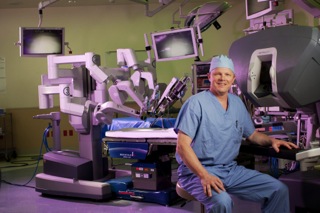Robotic and Laparoscopic Surgery

OHSU is home to one of the most comprehensive robotic surgery programs on the West Coast, enabling the Department of Urology to offer the most innovative procedures in robotic surgery that treat a wide variety of urologic conditions. OHSU Urology boasts a comprehensive surgical program that offers the very latest in surgical treatment methods. Our doctors perform both laparoscopic and robotic surgery to correct a great variety of urologic concerns.
Robotic prostatectomy
Surgical removal of the prostate gland, or radical prostatectomy, is one of the most common treatments for men with prostate cancer. This surgery can be done utilizing a traditional open approach through an incision in the lower abdomen, or a minimally invasive approach using robotic-assisted laparoscopic technology. At OHSU, nearly 100% of radical prostatectomies are done using robotics, even for complex and challenging surgical cases. The precise nature of the robot coupled with the skill and extensive experience of our urologic surgeons allows for maximum nerve sparing, which can help preserve erectile function, and ensures the most favorable outcomes.
Robotic nephrectomy
The vast majority of procedures that treat kidney cancer performed at OHSU are now done via a purely laparoscopic or robotic-assisted laparoscopic approach. In these procedures, several tiny “keyhole” incisions are made in place of larger incisions, resulting in less post-operative pain, decreased blood loss, and quicker recovery. The robotic approach is particularly suited for partial nephrectomy since the robotic technology and improved vision facilitates kidney reconstruction after removal of the tumor.
Robotic cystectomy
For those patients with bladder cancer that elect to have the bladder removed, surgeons at OHSU have offered a minimally invasive option for surgical bladder removal utilizing the da Vinci Surgical System, which imitates the movements of a human surgeon’s hands while increasing precision. Here at OHSU, we have more experience with this approach than any other institution in the Northwest. While open surgery involves an extensive incision, robotic surgery is done through small incisions in the abdomen, and unlike laparoscopic approaches, permits clear visibility with 3D, high-definition imaging. Patients who opt for robotic-assisted cystectomy tend to experience less pain, less blood loss, rapid recovery, shorter hospitalizations and fewer complications compared to those who undergo traditional open cystectomy. Particularly for patients with health issues that make them ineligible for open surgery, this alternative can be an important consideration in their treatment.